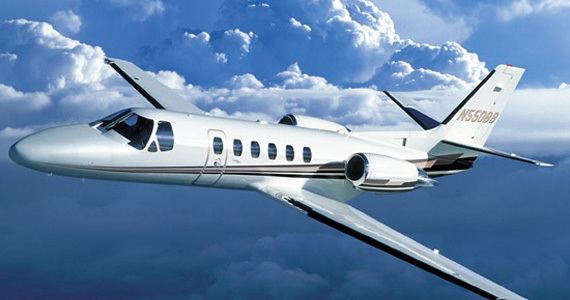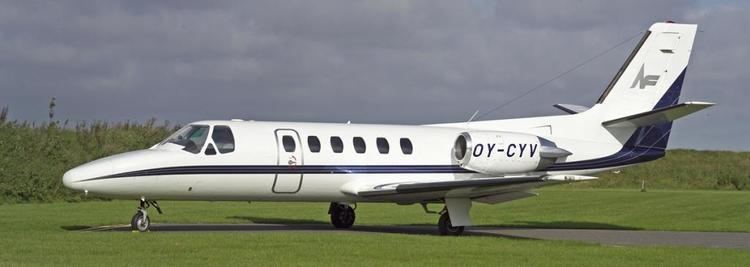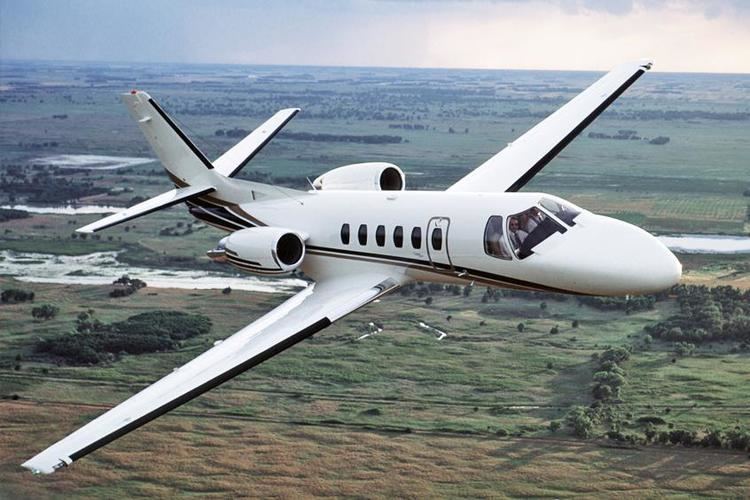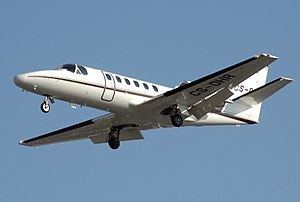Top speed 746 km/h First flight January 31, 1977 | Length 15 m | |
 | ||
Engine type Pratt & Whitney Canada JT15D | ||
Dynam turbojet 550 aka cessna citation ii beautiful sunset flight
The Cessna Citation II was the first of the Model 550 series of Citation jets, which are light corporate jet built by Cessna. A direct development of the Citation I, the Citation II led to the later development of the Citation II/SP, the S550 Citation S/II, and the Citation Bravo. The Citation II was also used by the United States Navy under the designation T-47A for radar system training.
Contents
- Dynam turbojet 550 aka cessna citation ii beautiful sunset flight
- Dynam turbojet 550 cessna citation ii dusk flight 1 of 2
- Citation II
- Citation IISP
- T 47
- Citation SII
- Citation Bravo
- Variants
- Military operators
- Specifications Cessna S550 Citation SII
- References

Dynam turbojet 550 cessna citation ii dusk flight 1 of 2
Citation II

The Citation II, Model 550, was a direct development from the Citation I. The earlier aircraft's success in the market led Cessna to believe there was demand for a larger aircraft that utilized the same design philosophy. The result was the Citation II, which had a maximum seating capacity of 10. In addition to more seats, the plane had more powerful JT15D-4 engines (2,500 lbf (11 kN) thrust per engine), increase of fuel capacity to approximately 5000 lb, faster speeds and longer range. First flight was on 31 January 1977, and the aircraft was certified for two-pilot operation in March 1978. A total of 603 aircraft were built before the Citation II was replaced by the Bravo in the production line.
The US Customs & Border Protection purchased ten Citation IIs configured with fire control radar (initially the F-16's APG-66(V), later the Selex ES Vixen 500E system) and the WF-360TL imaging system. These aircraft have been used effectively in Panama, Honduras, Colombia, Peru, Venezuela, Mexico and Aruba and are not to be confused with the similar OT-47B aircraft, which are based on the Cessna Citation V airframe.
Citation II/SP

Like the Citation I/SP, the Model 551 Citation II/SP was launched as Cessna's means of competing in the turboprop market, which predominantly are operated single-pilot, so the aircraft was re-certified for single-pilot operations.
T-47
The Model 552 T-47A was the designation given by the U.S. Navy to the Citation II. Fifteen aircraft were purchased by the Navy to train Naval Flight Officers, primarily its Navy F-14 Tomcat Radar Intercept Officers, Navy and Marine Corps A-6 Intruder Bombardier/Navigators, Navy and Marine Corps EA-6B Prowler Electronic Warfare Officers, Marine Corps F/A-18D Hornet Weapon Systems Officers and Navy S-3 Viking Copilot/Tactical Coordinators. The T-47A was modified by incorporating JT15D5 engines, shortened wings, multiple radar consoles and the AN/APQ-167 radar system.
The T-47As were operated by Training Air Squadron Eighty Six (VT-86), which was based at Naval Air Station Pensacola, Florida. All but one of the T-47As were destroyed in a hangar fire, and the Navy replaced them with upgraded T-39s
Citation S/II
In October 1983, Cessna announced that they would be improving the aircraft, and the upgraded Model S550 Citation S/II first flew 14 February 1984. The S/II could seat a maximum of 11 people. The aircraft utilized an improved version of the engine, JT15D-4B (2,500 lbf (11 kN) of thrust). The "B" in the engine model number consists of components in the hot section being replaced with components sustaining higher IT temperatures which in turn allows for a higher N1 percentage of 106%, a full 2% more than the JT15D-4 engines installed on the Citation II. The main benefit of the percent increase provided more thrust at higher altitudes. Fuel capacity was increased to a total of 5820 lbs. The rest of the improvements were aerodynamic in nature. The wing was replaced with one using a supercritical airfoil, which had been developed for the Citation III. The leading edges of the wing and tail used TKS type anti-icing fluid in addition to bleed air used for the engines. Once certification was in hand, the S/II replaced the II in the product line in late 1984. However, due to market demands, the II was returned to production in 1987. The S/II was discontinued after the 1988 production year. The number of S/II's produced is approximately 160. The II continued in production until 1994, and was replaced by the Bravo in 1997.
Citation Bravo
By 1994, the Citation II and S/II had been in production for 10 years, and it was time to integrate new technology. Cessna thus announced the development of the Citation Bravo. While it was built on the basic II airframe, the new aircraft was powered by Pratt & Whitney Canada PW530A engines. The main landing gear was replaced by the smoother-riding trailing link configuration adopted by other members of the Citation line, and the standard avionics suite was updated to the Honeywell Primus 1000 glass cockpit. The new aircraft first flew on 25 April 1995, but certification did not come for over a year, finally being granted in August 1996. Production of the Bravo ceased in late 2006 after 337 had been produced.
Variants
Military operators
Specifications (Cessna S550 Citation SII)
Data from Jane's All the World's Aircraft 1993–94
General characteristics
Performance
